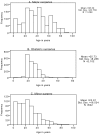Essential surgery at the district hospital: a retrospective descriptive analysis in three African countries
- PMID: 20231871
- PMCID: PMC2834708
- DOI: 10.1371/journal.pmed.1000243
Essential surgery at the district hospital: a retrospective descriptive analysis in three African countries
Abstract
Background: Surgical conditions contribute significantly to the disease burden in sub-Saharan Africa. Yet there is an apparent neglect of surgical care as a public health intervention to counter this burden. There is increasing enthusiasm to reverse this trend, by promoting essential surgical services at the district hospital, the first point of contact for critical conditions for rural populations. This study investigated the scope of surgery conducted at district hospitals in three sub-Saharan African countries.
Methods and findings: In a retrospective descriptive study, field data were collected from eight district hospitals in Uganda, Tanzania, and Mozambique using a standardized form and interviews with key informants. Overall, the scope of surgical procedures performed was narrow and included mainly essential and life-saving emergency procedures. Surgical output varied across hospitals from five to 45 major procedures/10,000 people. Obstetric operations were most common and included cesarean sections and uterine evacuations. Hernia repair and wound care accounted for 65% of general surgical procedures. The number of beds in the studied hospitals ranged from 0.2 to 1.0 per 1,000 population.
Conclusion: The findings of this study clearly indicate low levels of surgical care provision at the district level for the hospitals studied. The extent to which this translates into unmet need remains unknown although the very low proportions of live births in the catchment areas of these eight hospitals that are born by cesarean section suggest that there is a substantial unmet need for surgical services. The district hospital in the current health system in sub-Saharan Africa lends itself to feasible integration of essential surgery into the spectrum of comprehensive primary care services. It is therefore critical that the surgical capacity of the district hospital is significantly expanded; this will result in sustainable preventable morbidity and mortality. Please see later in the article for the Editors' Summary.
Conflict of interest statement
The authors have declared that no competing interests exist.
Figures


References
-
- Bickler SW, Spiegel DA. Global surgery–defining a research agenda. Lancet. 2008;372:90–92. - PubMed
-
- Luboga S, Macfarlane SB, von Schreeb J, Kruk ME, Cherian MN, et al. Increasing access to surgical services in sub-saharan Africa: priorities for national and international agencies recommended by the Bellagio Essential Surgery Group. PLoS Med. 2009;6:e1000200. doi: 10.1371/journal.pmed.1000200. - DOI - PMC - PubMed
-
- Bickler SW, Telfer ML, Sanno-Duanda B. Need for paediatric surgery care in an urban area of The Gambia. Trop Doct. 2003;33:91–94. - PubMed
-
- Weiser TG, Regenbogen SE, Thompson KD, Haynes AB, Lipsitz SR, et al. An estimation of the global volume of surgery: a modelling strategy based on available data. Lancet. 2008;372:139–144. - PubMed
-
- Nabembezi JS, Nordberg E. Surgical output in Kibaale district, Uganda. East Afr Med J. 2001;78:379–381. - PubMed

